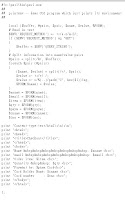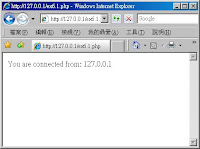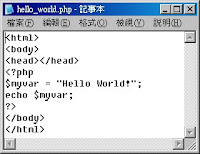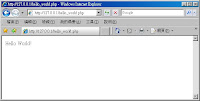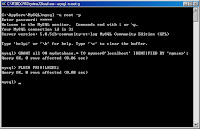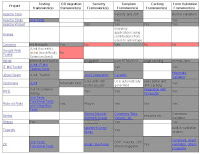1. Go to the website of IBM, Oracle, Microsoft and Sybase. Is there any mention of e-commerce associated with their database products? What suite or partnership do they list with related e-commerce offerings? How do they compare with open source product like MySQL?
IBMIn the website of IBM, the product associated to e-commerce is WebSphere Commerce.
This product comes with three difference versions: Enterprise, Professional and Express. Each version is designed for difference size of companies and the business use.
The database associated with the WebSphere Commerce is the DB2 database from IBM.
The DB2 is the unique choice for the express version of Websphere. In the Professional and Enterprise version of the WebSphere, Oracle Database can be chosen as the database backend as shown in Figure 1.

Figure 1. Database Choice for Websphere (IBM)
OracleIn Oracle website, the product found for the e-commerce is E-Business Suite.
However, the E-Business suite provide Oracle's database product to their customers only.
During 2002,
Red Hat India partner with Oracle to deploy the products into Linux platform.
There are several
partners with Oracle including Independent software vendor, Platform partners, System integrator and reseller and distribution Alliances.
MicrosoftThe Micrsoft provide e-commerce solution with
Microsoft Commerce Server.
According to Microsoft (2009), the commerce server requires Microsoft SQL server as its database (Figure 2).

Figure 2. Partial requirement of the Commerce Server 2009 (Microsoft MSDN)
SybaseSybase provides Sybase Enterprise Application Server as its product for e-commerce.
The database system used by the server is the Sybase Adaptive Server.
The database comes with three editions: express, developer, small business and enterprise (Figure 3).

Figure 3. Sybase Adaptive Server Enterprise Editions (Sybase 2007)
Comparasion between databases:

Figure 4. Hardware requirement of the database (Alesheikh, A. A., Dodge, S.)

Figure 5. Comparasion on features of database (Alesheikh, A. A., Dodge, S.)

Figure 6. Comparasion on database as review (Alesheikh, A. A., Dodge, S.)
MySQL is a free SQL server with minimum system reqirement and resources. Oracle and DB2 and MySQL database can run on all operating systems. By comparing the storage space and easy to use, Microsoft's SQL Server provide friendly-to-use interface while DB2 and Oracle database can support terabytes data. (Alesheikh, A. A., Dodge, S.)
2. Why is the perception getting stronger that integration will become critical factor in coming days? What is the role of AJAX within enterprise software architecture?
The traditional way (Figure 7) which only use the web server to handle the users requests for dynamic information leads heavy server requests. The loading time and response time of the web application become long and may be unacceptable. When there is a web application require user to interact frequently, the web application server and web server may not be able to handle with.
With the use AJAX, the faster response time is made and a large number of the server requests decreases. It is because of the use the AJAX engine. The AJAX engine like a hidden layer to both web server and user interface. It is used to handle the requests which does not transfer back to server, for example, simple data validation and editing data in memory. When there is a request requiring servers' response, the request will be handled asynchronously. (Garrett 2005)

Figure 7. Classic Web Application Architecture (Denis)

Figure 8. The traditional model for web applications (left) compared to the Ajax model (right). (Garrett 2005)

Figure 9. The synchronous interaction pattern of a traditional web application (top) compared with the asynchronous pattern of an Ajax application (bottom). (Garrett 2005)
3. What are the similarities between the object-oriented developemnt using model-view-controller (MVC) in Ruby on Rail 2.0 and Action Script 2.0 (Flash Animations)?
There are several similarities between them:
Both emphize DRY (don't repeat yourself) / code reuse concept.
According to Colin (2004), the classes and interfaces of the mvc in Adobe Actionscript 2.0 are:
View: An interface all views must implement
Controller: An interface all controllers must implement
AbstractView: A generic implementation of the View interface
AbstractController: A generic implementation of the Controller interface
According to Michael (2007), the classes and interfaces of the MVC in Ruby on Rails are:
Controller: Interacts with Model and View.
Model: Data representation and business logic.
View: Rends the Model in to a View
Model: ActiveRecord
Contains business logics
View: ActionView
It is used to renders the view
Controller: ActionController
It is used to control application flow and the view to use
Reference:
IBM (n.d.),
WebSphere Commerce V6.0 software requirements - Windows, Retrieved 10 April 2009 from http://www-01.ibm.com/support/docview.wss?rs=3046&uid=swg27007591
Microsoft (n.d.), Commerce Server 2009, Retieved 10 April 2009 from http://www.microsoft.com/commerceserver/en/us/overview.aspx
Oracle (2002), Red Hat India Partners With Oracle India,
Retrieved 10 April 2009 from http://www.oracle.com/global/in/pressroom/redhatpartner.html
Oracle (n.d.), Oracle E-Business Suite Tools and Technology,
Retrieved 10 April 2009 from http://www.oracle.com/technology/products/applications/ebs/index.html
Sybase (n.d.), Sybase EAServer 6.0 Data Sheet, Retrieved 10 April 2009 from http://www.sybase.com/detail?id=1061861
Sybase (2007), Sybase Adaptive Server Enterprise Editions, Retrieved 10 April 2009 from http://www.sybase.com/files/Data_Sheets/ase_clusters_ds.pdf
Alesheikh, A. A., Dodge, S. (n.d.), Evaluating different approaches of spatial database management for moving objects, Retrieved 10 April 2009 from http://www.gisdevelopment.net/technology/gis/me05_021b.htm
Interakt (10 November 2005), AJAX: Asynchronously Moving Forward, Retrieved 10 April 2009 from http://www.interaktonline.com/support/articles/Details/AJAX%3A+Asynchronously+Moving+Forward-Introduction.html?id_art=36&id_asc=306
Garrett, J. J. (18 February 2005), Retrieved 10 April 2009 from http://www.adaptivepath.com/ideas/essays/archives/000385.php
Denis, H. (n.d.), Software Architecture, Retrieved 10 April 2009 from http://coronet.iicm.tugraz.at/sa/s5/sa_www.html
Colin, M. (2004), Essential ActionScript 2.0 [Electronic verion], O'Reilly, Retrieved 10 April 2009 from http://www.adobe.com/devnet/flash/articles/mv_controller/as2ess_ch18.pdf
Michael P. J. (2007), MVC Demystified: Essence of Ruby on Rails, Retrieved 10 April 2009 from http://www.slideshare.net/codeinmotion/mvc-demystified-essence-of-ruby-on-rails






